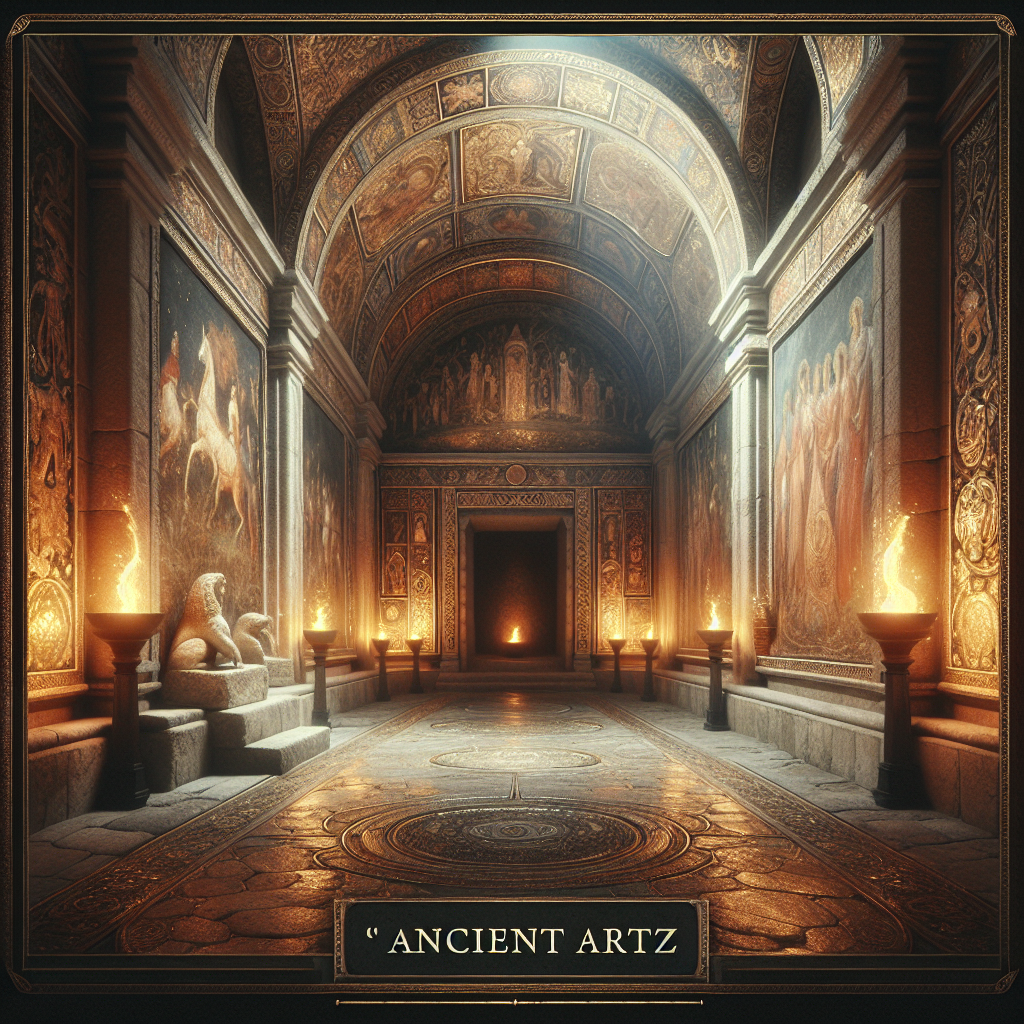The ancient art is a deep reflection of past societies and its people. The “Ancient Artz” tells the story about how complex these early art painstakingly became in sculpture, in paintings, and in pottery. In this case, we shall examine some of the different cultures of the world and how they expressed their works of art in ancient times, what symbolism was used in these art works and the influence of ancient art on contemporary art.
Early Beginings of Ancient Artz
We have to conclude art is a human physical story-teller. The power of “Ancient Artz” goes back at least 30,000 years to humanity’s earliest present in its form of art. During the paleolithic stage of mankind, artists made walls of caves, chiseled rocks, and tools which were believed to be the very first steps of evolution. In addition, those early pieces of artwork served as a precursor for more elaborate artistic achievements in later civilizations.
Icons in Arts Across Cultures
As well as in numerous other spheres, every ancient culture has its own twists in forming the art and it shaped the concepts and ideas through its own styles, techniques and symbols.
Egyptian Art
Symbolization and rigidity are perhaps the two defining features of Ancient Egyptian art which every person will automatically recognize. The Egyptians had faith in life after death and created art to put on display their gods, their pharaohs, or their everyday life activities. Those tombs, as well as paintings, and incised images, statues, and pottery, depicted the Egyptian pantheon, royal rituals and some mythological scenes. A common feature of Egyptian art is the so-called “composite view,” where heads and legs of the people were shown in profile while their torsos were depicted frontally. This type of depicting make their leaders or the deities appear to be somewhere sanitary and godly.
Greek and Roman Art
The Greeks and the Romans looked upon art as a tool of glorifying one particular aspect of human existence – the body in its most perfect forms. In time Greek Art changed from the use of ordinary geometric patterns on pottery to sophisticated sculpture of gods, heroes and athletes relying much on symmetry and proportions. The Romans brought a development of Greek art which added in their works realism in sculptures and reliefs. The walls were filled with Roman mosaics and frescoes which depicted ordinary life and meaningful events, because of their obsession with realism.
Mesopotamian ArtMesopotamia, the “cradle of civilization,” is the home of some of the earliest discovered writing and sophisticated carvings. Deities and mythological storytelling were often stylized in arts from this area. Pyramids or the ziggurats in this case are architectural art typical to Mesopotamian civilization. They showed artworks in form of clay and stone sculptures and reliefs that focused on holy beings, kings, and catholic wars showcasing the strength of god and the rulers. Chinese ArtChinese art over Shang and Zhou dynasties originated and it is being full of sign and influenced much by constant philosophical elements, mostly Confucianism and Daoism. Carving fine jades, making bronzes and calligraphy are some of the schools of art practiced by the Chinese in the early days. Pure and delicate in itself, jade is thought to be the epitome of esteem and dignity. These motives prevailed in Chinese paintings which aimed at the unity of men and nature. Some artists painted landscapes while others portrayed plants and animals symbolically.
Art of Native American Tribes and Their Creation
Art in the Americas, as with the Maya, the Aztec and the Inca, was specific in its own way, and was greatly influenced by religion. This is a culture that consists of stone carvings, murals and pottery depicting gods and other cosmic imagery among the Maya and the Aztecs. Incas understood how to work in metals and created various artifacts made of gold, silver and copper that had a symbolic meaning of power and strong spiritual value. Art was not simply a method of creative expression, but was also inextricably associated with the worship of gods and sun cycles, which were both important parts of their religious culture.
Mayan Art and Culture – Ancient Techniques and Materials
To create their artwork, ancient artists used different materials and employed different techniques, which then contributed to the skilled craftsmanship as well as the knowledge of the resources at one’s disposal.
Sculpture: A large number of ancient civilizations employed stone sculpture as a primary form of medium primarily owing to its strength and high resilience to external elements. There were variations in techniques, with chiseling, hammering and some civilization even utilizing fire to sculpt out stones which were used in creating statues, buildings and monuments.
Art, Metahics and Drawing: Pottery has been identified as the most popular skill by ancient artists in relation to art and for decorative purposes. Coiling, throwing and firing practices and processes was done by ancient potters producing strikingly designed vessels and jars. Figures and images painted on pottery showed people’s lives, scenes from Olimp and nature.
Metalwork: Metalworking was done by many ancient peoples, the Egyptians as well the Incas for instance. Jewelry, religious Images, and weapons were made of gold, silver, bronze and iron. This knowledge was professional, thus was many times linked to nobility or divine.
Painting and Pigments: Cave pictures, Graphics Scribes of murals and the violence of history helped tell the story and depict the future of the tragic events. They used natural pigments like ochre, charcoal, or even minerals in order to create saturation. Capturing images was going deep into trance like states, because it was believed that pictures could create protection.
Symbolism and Meaning in Ancient Artz
Ancient Artz was extreme phenomena of beauty mainly due to its motifs, had deeper hidden meanings in them.
Religious and Mythological Themes: The works were producing offering their audiences and their fans to kings and supernatural gods and deities. A Classic example can be found in India, in the Hindu Temple ancient art or Buddhist temples all representing a ‘search’ for the light. The art of the Ancient Egyptians had a lot to do with the symbolism of the afterlife while the Greeks celebrated myths of the heroic and divine.
Nature and Animals: Animals and plants were parts and parcel of ancient art with natural representation depicting life, fertility as well as strength. Source of life: Egyptian art Love the river Nile and greek pottery Heuses depicted Animals to represent strength and wisdom as well.
Rulers and Divine Authority: What’s interesting comes from the fact that this represented an ascribed role; unlike other fraud of violating the status-quota of a ruler a monarch had actual divine powers. Returning to the ball of Assyria for a moment, the statues of winged bull pictured in the Salus book have connotations of royal power and protection.
Monarchy, the Assyrian Chronology and its traces in the contemporary world
Influences of actors from ancient times definitely impacts on the three today – the art, the architecture and the P culture. Today we have numerous museums pampering numerous ancient artifacts that have rationale and beauty. Most of today’s artists are also inspired by the traditions of the civilization that represents the ancient world and therefore, the culture, motifs, techniques and themes from the past are never overshadowed.
Modern archetypes borrow ideas from mystical ancient worlds that inspire the movie industry, works of literature and, for instance, today’s fashion designers who integrate Medusa to Egyptian hieroglyphs and Greek statues into brand new styles. This devoted popularity to the ancient art and its prominent figures allows the modern generation to stay connected to the real crafts and brains behind these works.
Assessment of Ancient Art and its Current Importance
In my opinion, some artworks possess greater significance and purpose, but it also becomes evident why so many ancient specimens remain intact while others disappear due to a reason. At the moment, a lot is being done to support and cover damaged layers of culture and heritage, but this requires significant investment. It also sounds reasonable why a lot of these initiatives may struggle to be approved due to costs involved – government, museums and volunteers all spend significant time and financial resources in repopulating ancient centres and relics.
Conclusion
“Ancient Artz” embodies an inexhaustible human will to create and express one’s culture. From rock arts to colossal carvings, ancient art has never stopped to move and educate us. It transcends time. Because behind such art are people who lived long before us and people who created and believed in ideals and morals of those, who came before them. This kind of travel across ancient art helps us enjoy and appreciate the skill and imagination of the human spirit that has not changed.











